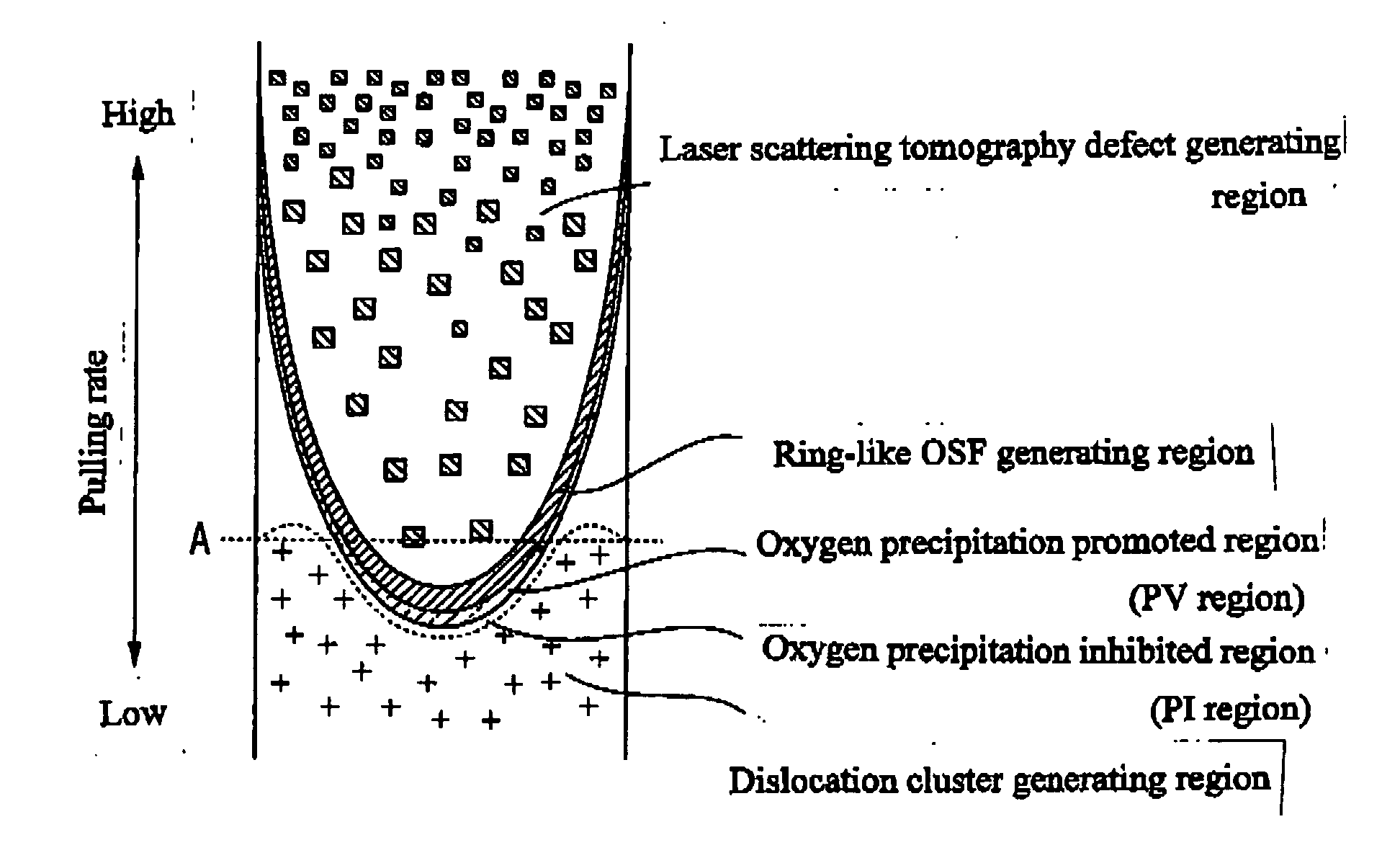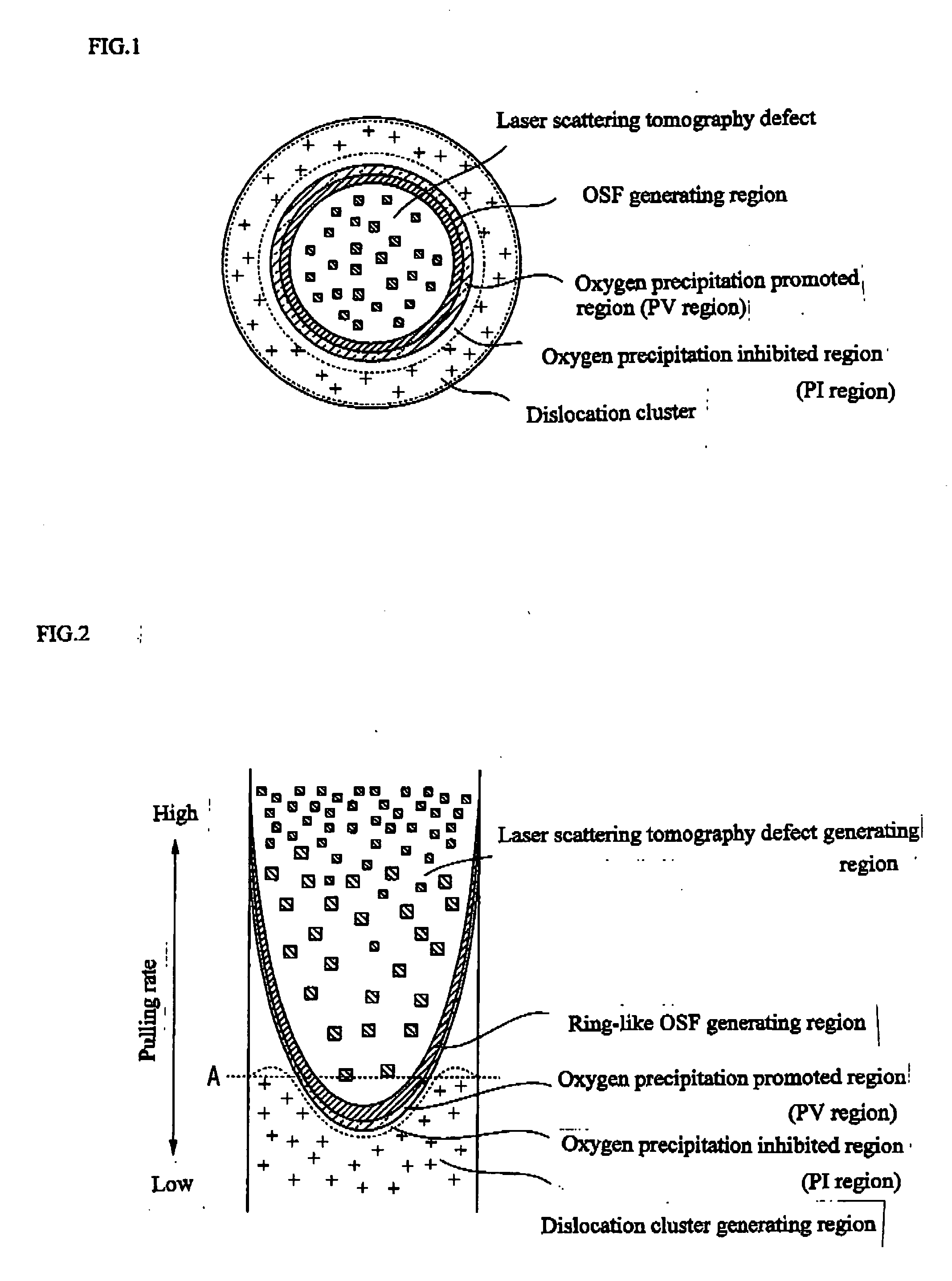Process for growing silicon single crystal and process for producing silicon wafer
a technology of silicon single crystal and growing process, which is applied in the direction of crystal growth process polycrystalline material growth, etc., can solve the problems of large cavity consisting of hydrogen defects, deterioration of gate oxide integrity, etc., and achieve the effect of increasing the pulling rate margin of a defect-free crystal, reducing the number of parts, and reducing the number of defects
- Summary
- Abstract
- Description
- Claims
- Application Information
AI Technical Summary
Benefits of technology
Problems solved by technology
Method used
Image
Examples
experimental examples 6 to 12
[0119] A silicon single crystal with a diameter of 300 mm was grown at a higher pulling rate than that at which the OSF region disappears at the crystal central part, using an apparatus for growing a silicon single crystal having a hot-zone structure in which the temperature gradient (Gc) in the crystal central part was the same as or greater than (Gc≧Ge) the temperature gradient (Ge) in a crystal perimeter part, while supplying an inert gas to which hydrogen was added to the pulling furnace so as to obtain the hydrogen molecular partial pressure in Experimental Examples 6 to 12 shown in Table 2, and then the resultant silicon single crystal was sliced to obtain a silicon wafer.
TABLE 2Position whereH2 PartialOSF-ring existsNumber ofPresence orExperimentalpressure(Wafer diameterLPDabsence of Example(Pa)ratio) (a / b)(pieces / wf)H2 defect6No doping0.48113. . .7300.5187None8400.7312None9400.262None102400.684Present112400.8843None124000.533None
[0120] With respect to the silicon wafer of ...
experimental examples 13 to 19
[0130] A silicon single crystal with a diameter of 300 mm was grown at a higher pulling rate than that at which the OSF region disappeared at the crystal central part, using the same apparatus for growing a silicon single crystal as in Experimental Examples 6 to 12, while supplying an inert gas to which hydrogen was added to the pulling furnace so as to obtain the hydrogen molecular partial pressure in Experimental Examples 13 to 19 shown in Table 3, and then the resultant silicon single crystal was sliced to obtain a silicon wafer.
TABLE 3Position wherethe OSF-ringH2 Partialexists (WaferNumber of Epi-defect (piece / wf)ExperimentalpressurediameterEpi-thicknessEpi-thicknessEpi-thicknessEpi-thicknessExample(Pa)ratio) (a / b)0.3 μm0.5 μm2 μm4 μm13No0.48694358624doping14300.5134316145315400.73587114316400.27141214172400.69645831182400.901145291817194000.55493722
Note:
“Epi” in Table 3 means “Epitaxial Layer”
[0131] With respect to the silicon wafer of Experimental Examples 13 to 19 thus obt...
experimental examples 20 to 26
[0139] A silicon single crystal with a diameter of 300 mm was grown at a higher pulling rate than that at which the OSF region disappeared at the crystal central part, using the same apparatus for growing a silicon single crystal as in Experimental Examples 6 to 12, while supplying an inert gas to which hydrogen was added to the pulling furnace so as to obtain the hydrogen molecular partial pressure in Experimental Examples 20 to 26 shown in Table 4, and then the resultant silicon single crystal was sliced to obtain a silicon wafer.
TABLE 4PositionNumber ofNumber ofwhere theCOP afterCOP afterH2 PartialOSF-ring existsgrindinggrindingExperimentalpressure(Wafer diameterby 5 μmby 10 μmExample(Pa)ratio) (a / b)(pieces / wf)(pieces / wf)20No doping0.49432721300.55313422400.776223400.2993242400.6578252400.872121264000.5956
[0140] With respect to the silicon wafer of Experimental Examples 20 to 26 thus obtained, the ratio (a / b) of the outer diameter (a) in the radial direction of the silicon sing...
PUM
| Property | Measurement | Unit |
|---|---|---|
| diameter | aaaaa | aaaaa |
| diameter | aaaaa | aaaaa |
| size | aaaaa | aaaaa |
Abstract
Description
Claims
Application Information
 Login to View More
Login to View More - R&D
- Intellectual Property
- Life Sciences
- Materials
- Tech Scout
- Unparalleled Data Quality
- Higher Quality Content
- 60% Fewer Hallucinations
Browse by: Latest US Patents, China's latest patents, Technical Efficacy Thesaurus, Application Domain, Technology Topic, Popular Technical Reports.
© 2025 PatSnap. All rights reserved.Legal|Privacy policy|Modern Slavery Act Transparency Statement|Sitemap|About US| Contact US: help@patsnap.com



